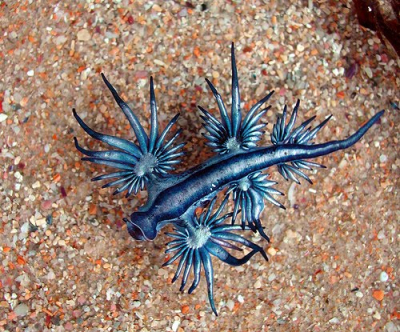What is a Blue dragon?

Also known as blue sea slugs, blue angels, and sea swallows, the blue dragons, or Glaucus atlanticus, are part of a group of creatures known as nudibranchs or sea slugs.
A few weeks ago, a beautiful blue creature was spotted in large numbers on the coast of the Indian city of Chennai. This occurred after the floods following the cyclone Michaung that hit the city. This poisonous deep sea creature called blue dragon attracted much attention among the public who were warned not to touch them. Now what is the blue dragon?
They are seen to drift away in the temperate and tropical waters of the Atlantic, Pacific and Indian oceans. But what helps the blue dragons stay afloat? It is an air bubble stored in their stomach that helps the sea creature in this.
While these creatures are tiny, growing to just about 1.2 inches long, they consume creatures that are many times their size, such as the Portuguese man o' war. When threatened, the blue dragons will sting. Their sting is venomous because of their diet which includes venomous creatures such as the Portuguese man o' war. They store the stinging nematocysts from the creatures they feed on and release these stinging cells when threatened. Even after they die, their venom remains active.
The creature is known for its camouflage capabilities. When floating, the blue underbellies against the ocean's blue colour camouflage them from predators above water. Meanwhile, the dull-coloured backside blends in with the bright surface of the water. This gives them protection from predators below. Blue dragons are hermaphrodites, that is, they have both male and female reproductive organs.
In many locations worldwide, blue dragons are being spotted for the first time and experts attribute reasons such as the warming ocean, increased storm activity, changes in Portuguese man o' war populations, and so on.
Picture Credit : Google